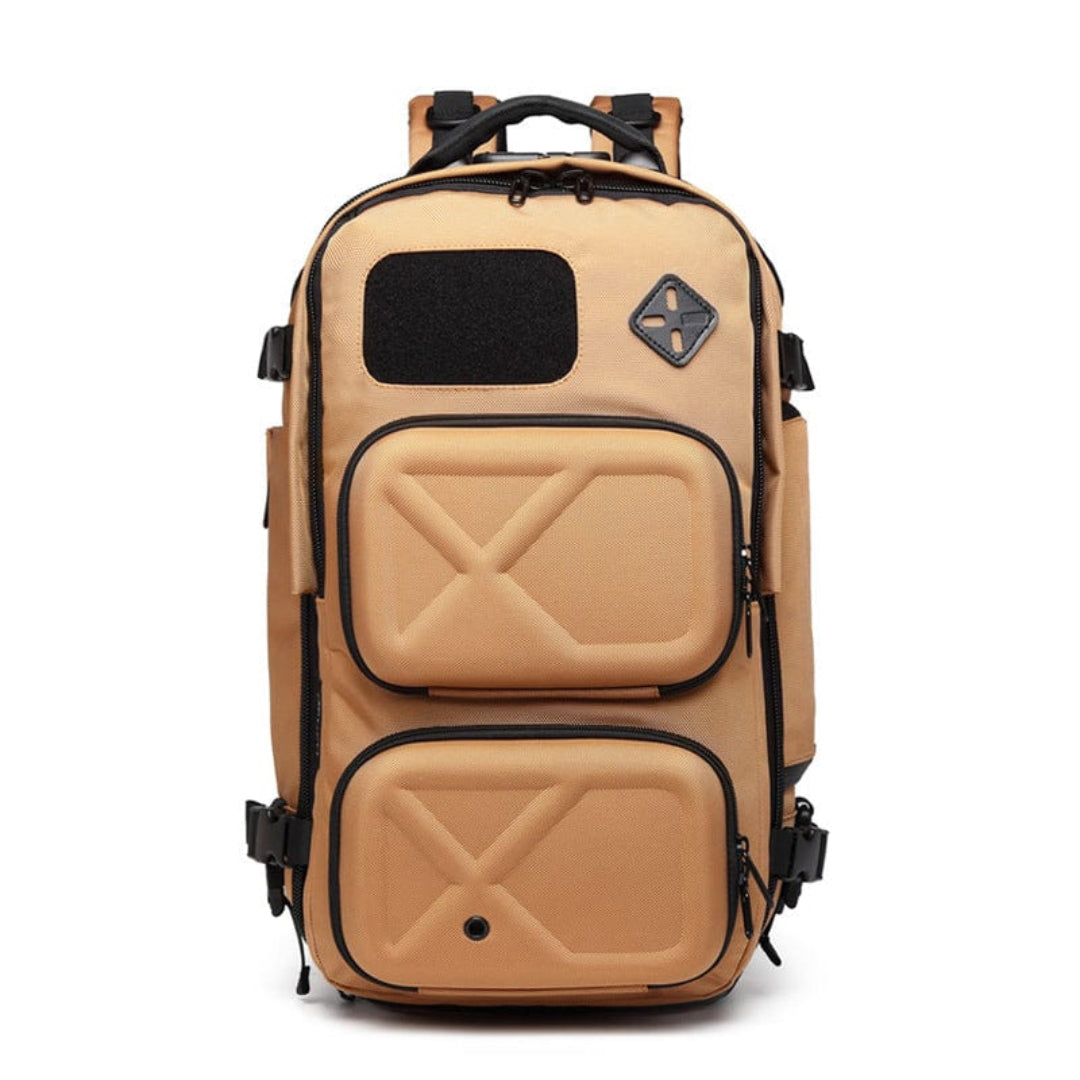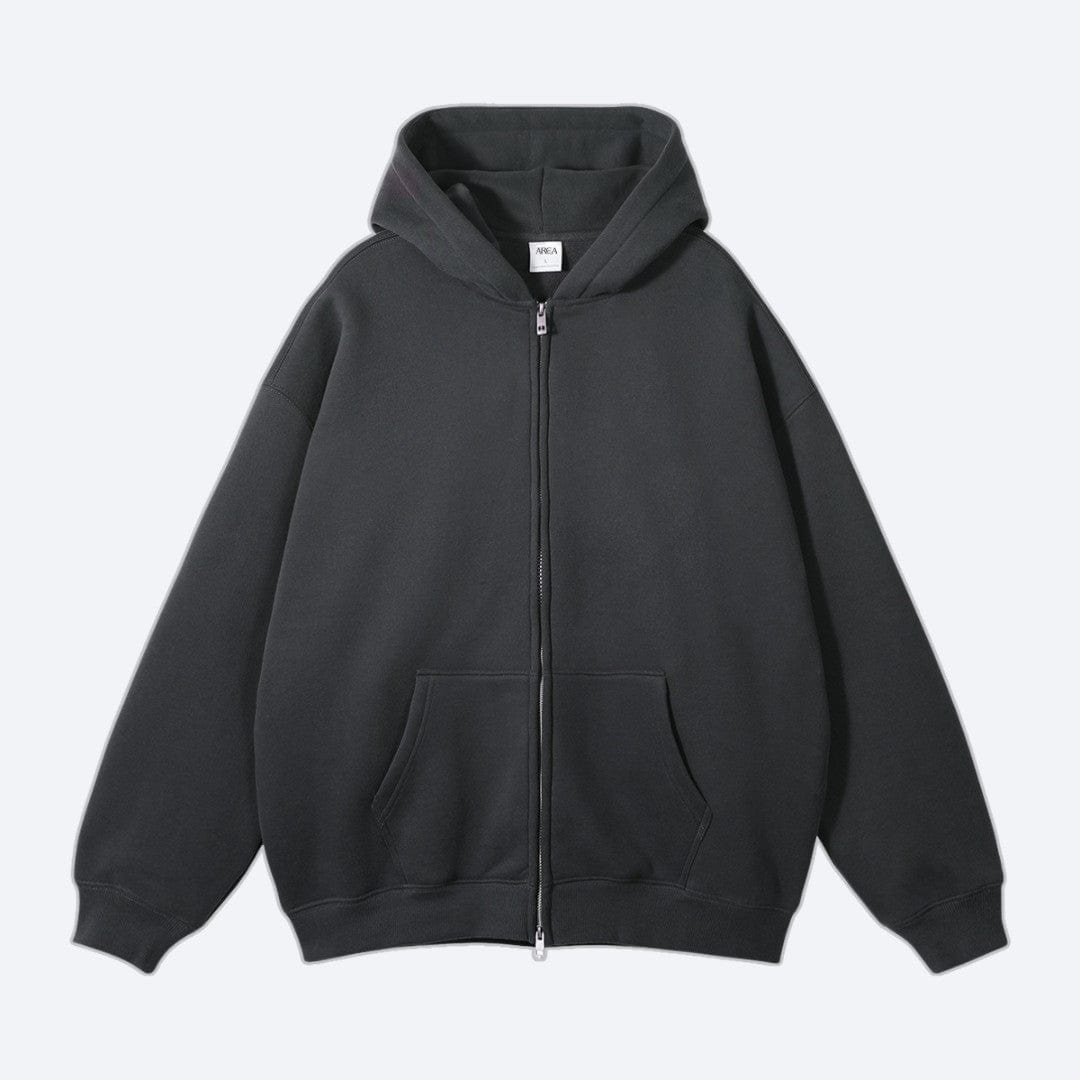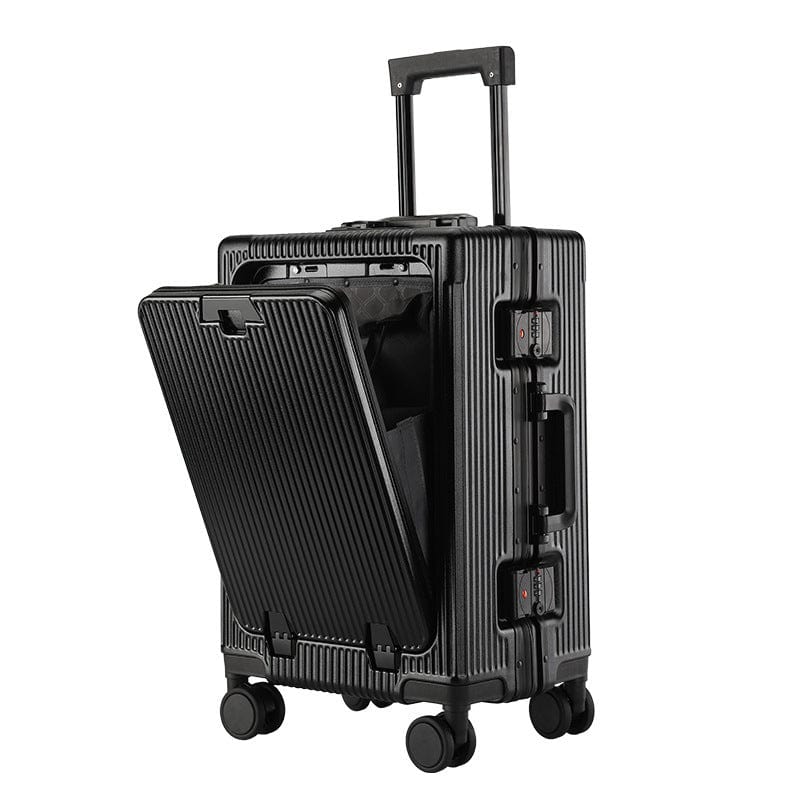Packing for a trip to Sweden can feel like solving a stylish puzzle. The weather changes quickly and the seasons bring their own unique challenges. One day you might enjoy warm sunshine in a cotton dress the next you could be reaching for a sweater scarf and coat. Swedish summers are mild but evenings can turn chilly while spring and fall often mean unpredictable rain and shifting temperatures.
What Luggage to Bring to Sweden
Choose a carry-on suitcase or travel backpack that allows space for layers without overpacking. Packing cubes help compress clothes and organize essentials, especially when planning for temperature swings.
Select luggage with waterproof material since Stockholm’s climate stays humid year-round, and sudden rain showers are common. Hard-shell suitcases keep contents dry. Backpacks with water-resistant coatings work for day trips and city exploring.
Keep your bag light by creating a capsule wardrobe with interchangeable neutral pieces such as sweaters, jackets, and pants. Compact accessories like a foldable umbrella and a packable wind- and water-resistant coat fit easily inside outer pockets. Rolling clothes lets you maximize space for bulkier items like sweaters and thermal underwear.
Bring a smaller daypack for outings. A 15–20-liter capacity backpack holds layers, snacks, gloves, and a scarf, making it easy to adjust when the temperature shifts. Include sunglasses and hand warmers in a dedicated compartment for quick access.
Combine bags with wheeled designs if you expect to move often between hotels, as cobbled streets in Stockholm can challenge rolling luggage. Otherwise, opt for a backpack if you’ll take public transport and walk frequently.
What Do People Wear in Sweden? Dress to Blend Right In
Swedish style emphasizes minimalism and functionality, with clean lines and neutral colors forming the foundation of most outfits. Neutral tones like black, white, gray, and beige dominate everyday attire, making mix-and-match layering simple and timeless. People in Sweden select quality fabrics such as wool, cotton, and linen—materials chosen for both comfort and durability.
Layering defines the Swedish approach to dressing, especially given the country’s shifting weather conditions. Everyday outfits often include tailored silhouettes: relaxed yet structured coats, straight-leg trousers, and knit sweaters are common examples. Outwear choices typically feature classic wool coats in winter and lightweight waterproof jackets for unpredictable seasons.
Scandinavians value versatility, so Swedes favor pieces adaptable to different settings—for instance, basic jeans, button-down shirts, and midi dresses. Accessories like simple scarves and leather boots finish looks without excess decoration. On city streets in Stockholm, locals showcase polished ensembles that balance practicality with understated elegance, reflecting Swedish fashion principles year-round.
Swedish Fashion Tips
- Prioritize Layering for Versatility
Layering creates adaptable outfits for unpredictable Swedish weather. Use base layers like thermal tops, mid layers such as wool sweaters, and outer layers, including tailored coats or waterproof jackets. Switch or remove layers indoors or when temperatures rise.
- Choose Neutral Colors for Easy Matching
Neutral colors like black, white, gray, and beige mix easily. Incorporate these shades in shirts, pants, outerwear, and accessories. Outfits built on neutrals achieve a cohesive, timeless appearance.
- Opt for Quality Fabrics with Comfort
Select natural materials such as wool, cotton, and linen for warmth and durability. Swedish fashion prefers these fabrics for sustainability and everyday comfort.
- Select Tailored Yet Relaxed Silhouettes
Relaxed straight-leg trousers and structured coats define Swedish street style. Pieces with subtle tailoring give polished looks without sacrificing comfort.
- Invest in Versatile Wardrobe Staples
High-quality essentials like denim jeans, classic sweaters, and multipurpose coats suit both casual and more formal plans. Simple boots or sneakers fit urban environments and address changing conditions.
- Add Subtle Personal Details
Scarves, hats, and minimalist jewelry showcase individuality while blending with Nordic minimalism. Accessories in neutral colors maintain overall coherence.

- Stay Practical with Footwear and Outerwear
Winter boots with insulation, water-resistant sneakers, and sturdy raincoats support comfort during city walks or outdoor activities. Traction helps on cobblestone or icy streets across Swedish cities.
- Pack for Season and Setting
Pack heavier scarves, gloves, and thick hats during winter, lightweight layers and versatile jackets in summer, and waterproof accessories for spring and fall showers. Adjust clothing choices depending on planned locations—city attractions, outdoor adventures, or evening dining.
|
Swedish Fashion Element |
Detail Example |
Reason
|
|---|---|---|
|
Layering |
Thermal base, wool mid |
Adapts to quick weather changes |
|
Neutral Colors |
Black coat, beige pants |
Achieves easy mixing and matching |
|
Quality Fabrics |
Wool sweater, cotton tee |
Comfort and durability |
|
Tailored Silhouettes |
Straight trousers, coat |
Combines polish and ease |
|
Versatile Staples |
Jeans, basic sweaters |
Suits various activities |
|
Functional Footwear |
Insulated boots |
Handles rain, snow, and cobblestones |
|
Minimal Accessories |
Knit scarf, plain hat |
Adds personal touch without excess |
Function Meets Fashion: Layering Is Essential
Packing layers optimizes your comfort and style in Sweden’s fluctuating climate. Layering in Swedish fashion means combining function, adaptability, and a polished appearance—necessary for adjusting to daily shifts in weather and local social norms.
- Thermal base layers Wearing long-sleeved thermal tops and leggings provides insulation against winter temperatures, especially when mornings start below freezing.
- Midweight knits and sweaters Choosing lightweight wool or cotton sweaters lets you regulate warmth without bulk; Swedes often select neutral, versatile knits for daily use.
- Water-resistant shells and jackets Donning waterproof or windproof shells shields you from sudden rain or snow, especially in spring and fall when showers are common.
- Multipurpose outerwear Opting for classic wool coats, insulated parkas, or lined rain jackets combines protection with a minimal, Scandinavian look.
- Practical accessories Adding hats, scarves, and gloves prevents heat loss in colder months, with most Swedes choosing unobtrusive designs in black, gray, or beige for coordination.
- Smart footwear Wearing boots in winter or water-repellent sneakers in wetter months keeps your feet comfortable across city streets and nature walks.
Swedish layering ensures you stay comfortable in unpredictable weather, using neutral tones and quality fabrics like wool, cotton, or technical synthetics for durability and style. Removing or adding layers as temperatures change—indoors or outdoors—matches local habits and maximizes versatility. Clothing fit stays slightly relaxed, so pieces nest comfortably, showcasing Scandinavian minimalism while meeting functional needs.
What to Wear in Sweden in Summer
Pack light, layerable clothing for Sweden's summer, as daily temperatures can swing from 60°F to 77°F, with cooler nights near 50°F, according to Swedish climate records. Bring short-sleeve T-shirts, cotton dresses, skirts, and shorts for warm days. Include lightweight hoodies or jumpers for evenings, as temperatures drop quickly after sunset. Always carry a compact jacket or windbreaker that blocks both wind and light rain, since sea breezes and showers occur randomly—even in July.
Choose neutral colors like navy, beige, gray, and white to blend with local Scandinavian style, which prioritizes simplicity and function. Opt for clothing cut with clean lines and minimal patterns; maritime stripes are especially popular in Stockholm during summer. Favor breathable materials such as cotton and linen for base layers, since these fabrics help regulate body temperature during unexpected warm spells.
Select versatile shoes, such as minimalist sneakers or sturdy sandals, as cobbled streets and coastal paths require comfort and support. Waterproof options are practical if you plan city walks or excursions to parklands. Always pack a compact umbrella in your daypack, since sudden rain showers are common.
Prepare a few smart outfits for evenings at restaurants or cultural events, prioritizing pieces that allow layers—light cardigans or wraps work well over dresses or shirts. You’ll find Swedes favor understated but polished looks, so avoid overly bright or flashy clothing.
|
Essential Summer Clothing |
Swedish Context |
Functionality
|
|---|---|---|
|
Cotton T-shirts |
Neutral colors |
Base layer comfort |
|
Light sweater/jumper |
Minimalist cut |
Warmth evenings |
|
Summer dress/skirt/shorts |
Maritime tones |
Versatile daytime |
|
Light jacket/windbreaker |
Rainproof |
Weather shield |
|
Sneakers or sandals |
Comfort |
City walking |
|
Umbrella |
Foldable |
Rainy days |
Stick to layered, neutral wardrobe staples to navigate Sweden’s unpredictable summer climate while fitting seamlessly with local trends.
What to Pack for Sweden in Spring & Fall
Packing for Sweden in spring and fall means preparing for unpredictable weather and frequent temperature swings. Layering remains essential, since temperatures can shift from 37°F in the early morning to 57°F by midday, and sudden rain is common. Choose base layers like thin merino or cotton tops, mid-layers such as lightweight knits or wool sweaters, and outerwear like a windproof, waterproof jacket.
Pack a compact umbrella and water-resistant shoes. Use footwear examples like minimalist sneakers or seamless boots to avoid wet feet on city streets. Include quick-drying socks for comfort in damp conditions. Accessories such as a lightweight scarf, beanie, and gloves offer added warmth if unexpected cold snaps hit.
Stick to neutral, coordinated colors—black, gray, navy, or beige—so you can mix and match layers easily, matching the minimal Swedish style. Select tailored but practical silhouettes, like straight-leg pants and versatile shirts, to transition from outdoor walks to city dining. Add a set of smart casual outfits for dinners or cultural outings; Swedes favor understated yet polished looks.
Bring a small daypack to store extra layers and essentials, since weather changes can be frequent when moving between neighborhoods or islands in Stockholm. Consider packing cubes for organization, as compact gear fits best within a carry-on.
|
Item |
Material/Feature |
Swedish Context Example
|
|---|---|---|
|
Base layers |
Cotton or merino wool |
Lightweight crew neck top |
|
Mid-layers |
Wool, thin knits |
Fitted cardigan |
|
Outerwear |
Waterproof jacket, shell |
Hooded parka |
|
Shoes |
Waterproof, slip-resistant |
Minimalist sneaker/boot |
|
Accessories |
Beanie, scarf, gloves |
Neutral color palette |
|
Daypack |
Compact, water-resistant |
Small 15L pack |
|
Umbrella |
Collapsible, wind-resistant |
Foldable travel umbrella |
|
Socks |
Quick-drying, cushioned |
Merino low-cut pair |
Adapt your outfits in line with Swedish preferences for functional, comfortable, and timeless design, ensuring you're ready for both outdoor adventures and city experiences.
Mastering Winter Layers in Sweden: What to Wear
Layering ensures warmth, comfort, and adaptability in Swedish winter conditions. Start with a moisture-wicking thermal base layer—merino wool or synthetic fabric options insulate without bulk and manage sweat. For example, merino thermal tops and leggings trap heat close to your body without restricting movement.
Choose insulating mid-layers next. Wool sweaters, heavy flannels, or quilted vests provide significant warmth for everyday activities and city strolls. Prioritize slim but roomy knits that accommodate a collared shirt or turtleneck underneath, allowing flexible combinations for changing temperatures.
Finish with a waterproof and windproof coat for outer protection. A heavy down parka or insulated technical shell blocks snow, rain, and wind gusts. Opt for longer hems and adjustable hoods—these block cold air at mid-thigh or lower. Water-resistant zippers and storm cuffs add extra shielding in wet conditions.
Select insulated, waterproof boots for your feet. Winter boots with high traction are vital for ice or slush; look for shearling or synthetic linings and sealed seams. Wool or thermal socks offer added insulation and moisture control.
Include practical accessories—wear a knit beanie, thermal gloves, and a thick wool scarf to preserve body heat and reduce wind exposure. Choose neutral colors like black, gray, or beige for a cohesive Scandinavian look that matches the local street style.
Adjust layers based on your activity level. Remove mid-layers during indoor gatherings, or add accessories when temperature drops outdoors. Use accessories like a lightweight puffer vest or a fleece-lined neck gaiter for extra adjustability on the go.
Prepare for intense sunlight after snowfall by packing UV-blocking sunglasses. Sunlight reflecting off snow can cause glare even in mid-winter.
|
Winter Layer |
Function |
Material Example |
Swedish Style Feature
|
|---|---|---|---|
|
Thermal base layer |
Moisture-wicking heat retention |
Merino wool, technical fabric |
Neutral, slim-cut |
|
Insulating mid-layer |
Warmth and flexibility |
Wool knit, flannel, quilted |
Minimal, classic, layerable |
|
Outer waterproof jacket |
Shield from snow, wind, sleet |
Down parka, shell, anorak |
Adjustable, practical |
|
Insulated waterproof boots |
Traction, foot warmth, wet protection |
Rubber, leather, faux shearling |
Chunky, supportive |
|
Thermal accessories |
Prevent heat loss from head, hands, neck |
Wool beanie, gloves, scarf |
Simple, neutral-toned |
Focus on high-quality fabrication to echo Swedish minimalism—wool, cotton, and technical fabrics last through multiple winters. Adapting these layering practices ensures you stay comfortable in Sweden’s winter while aligning with the understated, elegant street fashion seen across Stockholm, Gothenburg, and Malmö.
Things to Bring to Sweden Beyond the Wardrobe
Bring a universal travel adapter for Swedish type C or F power sockets, as outlets supply 230V at 50Hz. Pack a power bank for full smartphone access during day trips.
- Weather Protection and Health Items
Include compact umbrellas for unpredictable showers, with Stockholm averaging 170 rainy days a year. Carry SPF 30+ sunscreen, as UV exposure increases near water and snow. Pack lip balm and moisturizer for dry indoor air.
- Hydration and Personal Care
Carry a reusable water bottle, as tap water in Sweden ranks among the world’s cleanest. Pack travel-size toiletries since many Swedish accommodations use liquid soap dispensers instead of bars.
- Outdoor and Day Trip Gear
Bring sunglasses to counteract sun glare, especially on snowy or coastal days. Add hand and foot warmers for winter outdoor activities or northern excursions. Use a lightweight backpack for daily essentials and snacks.
- Travel Essentials for Comfort and Convenience
Include a travel-size first aid kit with pain relievers and plasters, since minor ailments can interrupt busy itineraries. Carry printed and digital copies of travel documents, as ID checks are common on intercity trains.
- Connectivity and Navigation Tools
Download offline maps and essential transit apps before arrival; cellular data costs for tourists may run high without local SIM cards. Carry a pocket-sized notebook and pen for addresses or reminders, as public Wi-Fi may be spotty in rural areas.
These items support your daily experience in Sweden by addressing the country’s unique climate, infrastructure, and travel patterns.
Summary
Packing for Sweden means embracing versatility and simplicity in your wardrobe. When you focus on quality layers and neutral colors you'll blend in with local style while staying comfortable through unpredictable weather.
Prioritize practical accessories and well-chosen staples so you can enjoy everything from city strolls to outdoor adventures with confidence. With the right approach you'll be ready for whatever Sweden has in store.





















